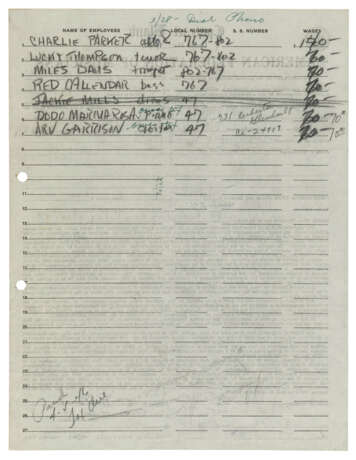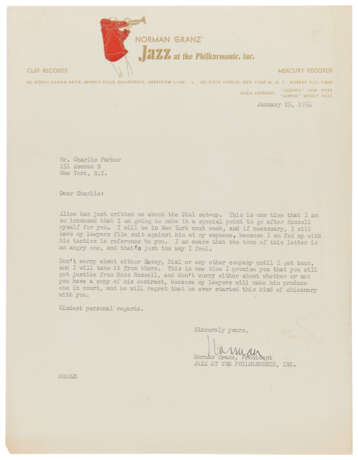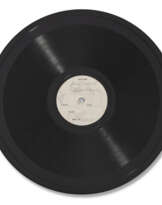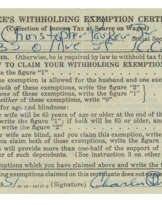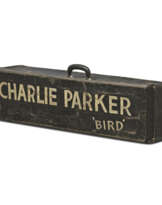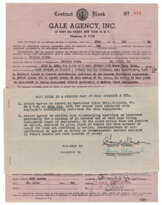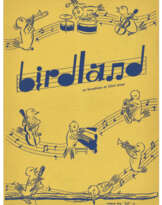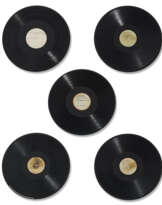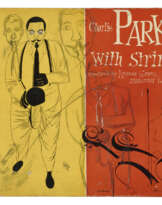ID 1016509
Lot 173 | Charlie Parker signs for The Famous Alto Break session
Estimate value
£ 6 000 – 8 000
Charles “Charlie,” Jr. Parker
PARKER, Charles “Charlie,” Jr. (1920-1955). Two part-printed documents signed in black ink ‘Charlie Parker’, 20 February and 25 March 1946.
Charlie Parker signs for The Famous Alto Break session.
Retained carbon copies of American Federation of Musicians employment contracts between Dial Records and Charlie Parker (as band leader) for recording sessions in Los Angeles, the individual musicians listed verso with their split of the agreed fee; the first for a ‘phantom’ session at Electro Broadcast Studios in Glendale on 4 March 1946, featuring a quintet with Howard McGhee on trumpet, Red Callender on bass, Jackie Mills on drums and Dodo Marmorosa on piano, specifying the agreed fee '$360.00' for the quintet, with ink alteration verso striking through Howard McGhee and replacing him with Miles Davis on trumpet, although Miles did not actually arrive in California until around two weeks later; the second setting up a five hour session at Radio Recorders on Santa Monica Boulevard on 28 March 1946, featuring a septet with Davis, Marmorosa, Calender, Mills (struck through), Lucky Thompson on tenor and Arv Garrison on guitar, specifying the agreed fee '$480.00' for the septet, with ink annotations verso indicating that Marmorosa and Garrison owed tax.
Following a residency with Dizzy Gillespie at Bob Berg’s in Hollywood, Parker pawned his ticket home and stranded himself in Los Angeles, signing a one-year exclusive recording contract with Russell’s Dial Records on 26 February 1946. ‘Parker’s Dial period straddles a near catastrophic personal crisis and a subsequent period of almost Buddhist calm,’ say Cook & Morton, ‘when his playing takes on a serene logic and untroubled simplicity.’ The latter contract documents one of Parker’s most legendary recording sessions with Dial, which yielded four classic performances in Moose the Mooch, Yardbird Suite, Ornithology, and A Night in Tunisia. Russell recalled: ‘The last side of the session was A Night in Tunisia. The first time around Charlie played a stunning break. When the master was played back, it was obvious this version could not be used. It was full of mistakes made by others. "I'll never make that break again," Charlie said. Nor was he quite able to duplicate the suspenseful line of the first effort.’ The famous alto break, Bird’s first run at the break on A Night in Tunisia, was ‘46 seconds of pure invention on the saxophone’ according to Cook & Morton. Russell described the seven-hour session as ‘an impressive display of disciplined musicianship... apart from Louis Armstrong I had never known a musician so committed or so wholly absorbed in the creative role.’ Writing for the Guardian, John Fordham identifies this session as one of the 50 great moments in jazz, indicating ‘how completely Parker had mastered his craft. His technique flawlessly adapted to the dazzling speed with which he could improvise fresh melody, change accents and rhythmic emphases from chorus to chorus, and hook together startling new lines from his voluminous mental library of phrases and themes.’ Cook & Morton, 1116. Fordham, for The Guardian (24 September 2009). Russell, 212.
Two pages, printed on both sides, each 278 x 216 mm, each with Parker’s signature at lower right, the second countersigned in ink by Ross Russell on behalf of Dial Records.
[And:] GRANZ, Norman (1918-2001). Typed letter signed ‘Norman’ to Charlie Parker, 25 January 1954, regarding Parker’s contractual disputes with Ross Russell of Dial Records. Granz writes: ‘Alice has just written me about the Dial set-up. This is one time that I am so incensed that I am going to make it a special point to go after Russell myself for you… if necessary I will have my lawyers file suit against him at my expense, because I am fed up with his tactics in reference to you… this is one time that I promise you that you will get justice from Ross Russell’. According to Brian Priestly in Chasin’ the Bird, the dispute stemmed from Russell’s decision to release The Famous Alto Break, eight years after it was recorded: ‘already within recent years Ross Russell had released, without further payment, several alternate takes of Charlie’s Dial dates. Now, at the start of 1954, he issued an LP that contained a 48 second extract from the first take of the 1946 Night in Tunisia (under the title The Famous Alto Break) as well as three partial performances of amateur recording quality from the following year’s Chuck Copely jam session.’ While the relationship between Parker and Russell was often contentious, it is generally agreed that Norman Granz’ influence was a positive one. ‘Norman was very supportive of Bird’, recalled Parker’s third wife Doris, ‘and Bird was glad to have him… he had somebody that was behind him, and Norman was recording him like mad.’ Hershorn, 183. Priestly, 98.
One page on Norman Granz’ Jazz at the Philharmonic, Inc. headed stationery, 277 x 215 mm. Provenance: The Chan Parker Collection, Christie’s London, 8 September 1994, lot 63 (part) – The Norman R. Saks Collection.
| Address of auction |
CHRISTIE'S 8 King Street, St. James's SW1Y 6QT London United Kingdom | |
|---|---|---|
| Preview |
| |
| Phone | +44 (0)20 7839 9060 | |
| Buyer Premium | see on Website | |
| Conditions of purchase | Conditions of purchase |



